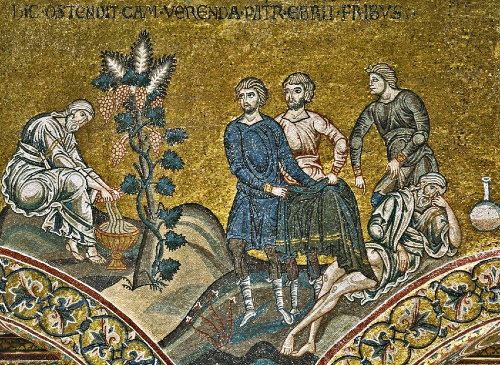Without a doubt, this is one of the most essential skills I know for identifying the Christ-story in the Old Testament. It can be a little challenging to get hold of, perhaps, but the benefits it yields will exponentially eclipse all efforts expended in learning to apply it.
At its heart, its all about using general, Christ-story terms to describe what is going on in a given passage. Take the very familiar story of Daniel 6, for instance. In specific terms, it is about Daniel, a man of great wisdom and devotion to God. The Lord’s favor is on him, as well as the favor of the Persian king—the most powerful individual in the known world. He lives counter-culturally at a time when that will bring much hardship from high-level Persian political leaders. The leaders are jealous of all the attention Daniel receives from the king, including his potential appointment over them. They find a way to make it look as if Daniel is opposed to the king and so, according to the decree of the king, himself, Daniel must die. With tremendous grief, the King sentences Daniel—his most trusted servant—to death, having him thrown into a pit filled with ravenous lions where he will most certainly never come out. The pit is sealed with the king’s ring. But miraculously, the next day, Daniel is not only alive but exits the pit without a scratch on him. Instead, those who tried to kill him are put to death immediately using the same means they intended against Daniel. Then the edict goes out to the known world that all people should worship the God of Daniel.
With only a very slight tweak in our spiritual vision, however, the Jesus story starts shining brightly through this ancient account. Let us tell the exact same story with slightly more general terms: There is a man of great wisdom and unquestionable devotion to God. The Lord God, who is the Great King over all the world, has all his favor resting on the man. The man lives in a way that is in opposition to the culture of his day and causes political and religious leaders to oppose him. The leaders who have held their positions for some time, overseeing the Great King’s business, are jealous of the attention given to this one upright man, both by the King and the people. The leaders make it look as if this good man opposes the Great King and, by the standards of the Law given by the King, sentence him to death. The righteous man is placed into a hole/pit in the ground from which he should never return and a stone rolled over the entrance and sealed by the governing power. However, only three mornings later, the righteous man exits the hole in the ground in a body completely clear of any sign of trauma. (Yet that same punishment given him was the very way in which those who sought his life were eradicated [Col. 2:13-15].) From that point, an announcement goes out to the world that all people are to worship the God of this one righteous man.
And there it is: The Jesus story. Frankly, it doesn’t even seem that well hidden when we simply speak in more general terms about what is going on. But let us take a look at another story to make sure we are understanding how to use this tool for interpretation.
In Joshua 1, Israel has ended a march through the desert that lasted forty years. They wish to enter the Promised Land that has been set apart for them by God, in which they will establish a kingdom. Joshua has been chosen by God as the leader who will go before the people in the stead of Moses who has died. Even though Moses could see the promised land at the time of his death, his previous violation of God’s strict command has kept him from being able to lead the people in. Joshua will be God’s instrument to take them through the Jordan River and go before them as all enemies are put in subjection under them. But first, they must wait for a three day period of preparation to transpire, at which time they will then follow their new leader and, as they have promised, any who do not obey Joshua with the same devotion as they obeyed Moses will be put to death.
Now again, let us take a step back, so to speak, and describe the same event with some general Jesus-story terms. The time of spiritual wandering is over. It is a new era in which the people of God will enter the kingdom that God has given them. A leader is set apart by God who will lead as Moses’ did before his death, overcoming the enemy and being God’s direct mouthpiece to teach them God’s ways. The words of God instruct all people about how they must live in this new world before them. But the violation of God’s command keeps even Moses from going into this time and place. The new leader raised up in Moses’ likeness will lead the people through the water and into a brand new environment and way of life, putting all enemies under subjection. This will only happen after an initial three-day period. Devotion to the leader who is raised up must be as steadfast as it was to Moses lest it result in the penalty of death for the disobedient.
Once again, by taking a step back and making ever-so-slight changes in general terms through which we tell the story of Joshua 1, we find that we have just told the story of Jesus. And, by the way, for those who may not be aware, “Joshua” is simply the Hebrew name, “Jesus.” If the rest of the story was not enough to get our attention, that little tidbit demands our full consideration.
This kind of thing can be used throughout the Old Testament. When you see an “older brother and younger brother” incident taking place (i.e., Cain and Abel, Esau and Jacob, Judah and Joseph, etc.) substitute “Israel” and “Jesus” and see what happens.
When you see two ladies compared or closely connected in some way, especially—but not necessarily—brides (i.e., Hagar and Sarah, Leah and Rachel, Naomi and Ruth, Vashti and Esther, the two widows associated with Elijah and Elisha, both sustained by almost endless quantities of oil), substitute the people of God under the Law (who are taken care of though not in the same way) and the people of God under Christ. (Paul does this himself in Galatians 4:21-31.)
When you see someone who is placed into a hole or pit or cave or well or cistern (i.e. Joseph, Moses, Elijah, Jeremiah, Daniel, etc.) ask yourself if this is somehow connected to the “tomb” of Jesus.. Is there some kind of dramatic transformation directly on the other side of the event? This kind of generalizing using Jesus-story terms can yield some of the greatest results imaginable.
Let the Christ story be your template for taking a new look at everything you’ve read or heard about the Bible for so long. You will discover the timeless story in places you have never conceived and in a depth of detail that will leave you breathless . . . generally speaking.





